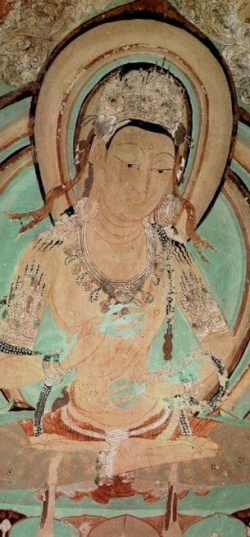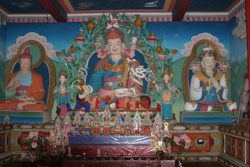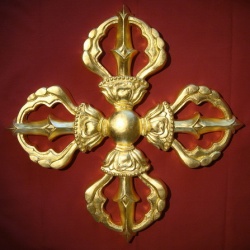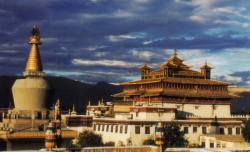In search of the Guhyagarbha tantra
The Guhyagarbha tantra is a vital part of Tibet’s Nyingma (“ancient”) lineages. And yet, ever since the 11th century, when certain partisans of the new translations questioned the authenticity of the Guhyagarbha tantra, its status became a disputed issue in Tibet.
The most detailed and sustained attack on the authenticity of the Guhyagarbha tantra was written by the 11th century translator Gö Khugpa Lhetse, based on his failure to find any lineage for the tantra in India and the fact that, according to his judgement, it didn’t resemble genuine Indian tantras. Gö Khugpa’s criticism was rather rash: features which he found suspect in the Guhyagarbha are in fact also found in tantras of the new translation period that he accepted. Nevertheless, enough doubt remained that the tantra was excluded from the scriptural canon (bka’ ‘gyur) compiled in the 14th century.
According to some Nyingma apologists, Gö Khugpa attacked the tantra because he had been refused certain transmissions by Zurpoché Shakya Jungne, one of the most influential Nyingma figures of that period. The story has some credibility, as Gö Khugpa is portrayed as a competitive and rather bad-tempered character in some non-Nyingma histories, including the Subtle Vajra, the early Sakya history translated by Cyrus Stearns in his book Luminous Lives. There we see Gö Khugpa falling out with his teacher Drogmi and trying to outdo him by travelling to Nepal to meet the great master Maitripa (in fact he meets Drogmi’s own teacher Gayadhara, who fools him into thinking he is Maitripa).
In any case, if Sakya scholars have not tended to join in these attacks on the Guhyagarbha tantra’s authenticity, it may be because Śākyaśrībhadra, the Kashmiri guru who taught Sakya Paṇḍita, verified a Sanskrit manuscript of the tantra which had been found at Samyé (this is mentioned in a 12th or 13th century Sakya biography of Śākyaśrībhadra). The manuscript was passed from hand to hand until it reached Gö Lotsawa Zhönu Pal, author of the Blue Annals, who wrote:
When the Great Kashmiri Pandita (Śākyaśrī) arrived at Samyé, he discovered the Sanskrit text of the Guhyagarbha. Later it came into the hands of Tatön Ziji, who presented it to it Shagang Lotsawa. The latter sent the manuscript to Chomden Rigpai Ralgri, who accepted it and composed The Flower to Ornament the Accomplishment of the Guhyagarbha. He showed the text at an assembly of tantrikas at Mamoné, and highly praised it. After that Tarpa Lotsawa made a translation of the Subsequent Guhyagarbha Tantra which had not been found before. Most of the pages of the manuscript were damaged. The remaining pages of the Sanskrit manuscript are in my hands.
So the authenticity of the Guhyagarbha tantra seems to be rather a non-issue, despite all the polemical activity devoted to the question over the centuries in Tibet. Still, some may be interested in the Guhyagarbha-related material that is to be found in the Dunhuang collections. While these manuscripts are alost certainly no earlier than the 10th century, they do provide some insights into the role of the Guhyagarbha in early Tibet:
Some of the sādhanas (manuals for meditation practice) quote the Guhyagarbha, though this is a little inconclusive, since (i) it is difficult to find exact parallel passages in the tantra itself and (ii) the Guhyagarbha is not mentioned by name. See for example IOL Tib J 332, which was originally noticed by Ken Eastman in his article listed below.
One manuscript (IOL Tib J 540) is a list of the mantras and the names of each of the 42 deities from the Guhyagarbha‘s peaceful maṇḍala.
One scroll, which I mentioned in the previous post (Pelliot tibétain 849), contains a list of tantras in Tibetan and Sanskrit. It includes the Guhyagarbha–listed as rgyud gsang ba’I snyIng po in Tibetan and ‘Gu yya kar rba tan tra in Sanskrit (the Sanskrit tranliterations on this scroll are wildly erratic). The scroll is, as I mentioned previously, probably notes from the teachings of an Indian guru who passed through Dunhuang on his way to China. However, it is dated to the very end of the 10th century, so this tells us little about the existence of the tantra in Tibet prior to this time.
Thus something of the Guhyagarbha tantra is there in the manuscripts, but it has a lesser presence than one might expect given its importance in the later Nyingma tradition. What is perhaps most striking is how many more references and quotations from a different tantra, the Guhyasamāja, are found among the manuscripts. The Guhyasamāja tantra itself appears in an almost complete manuscript (IOL Tib J 438), and is quoted more often and by name in various treatises and sādhanas. This raises the question of whether the Guhyasamāja tantra was actually more influential in pre-11th century Tibet than theGuhyagarbha tantra.
Perhaps the attacks on the Guhyagarbha and similar tantras were after all, as the Nyingma apologists suggest, politically motivated. In the struggles between the holders of the old lineages (i.e. the incipient Nyingmapas, the Zur family in particular) and the translators of the newly arrived tantric lineages, the Guhyagarbha was an easy target, as it was not featured in any of the new lineages, unlike the Guhyasamāja. Equally the Nyingmapas seem to have focussed more and more on the Guhyagarbha from the 11th century onward–perhaps exactly because it was not shared with the new schools.
References
1. Dorje, Gyurme. (no date). The Guhyagarbha Tantra: Introduction. Online at the Wisdom Books Reading Room
2. Eastman, Kenneth. 1983. “Mahāyoga Texts at Tun-huang”. Bulletin of the Institute of Cultural Studies, Ryukoku University 22: 42-60.
3. van der Kuijp, Leonard. 1994. “On the Lives of Śākyaśrībhadra (?-?1225)”. Journal of the American Oriental Society 114/4: 599–616. Available on JSTOR.
4. Martin, Dan. 1987. “Illusion Web: Locating the Guhyagarbha Tantra in Buddhist
Intellectual History”. Christopher I. Beckwith (ed.) Silver on Lapis: Tibetan Literary Culture and History. Bloomington: The Tibet Society. 175-220. Available for free download here.
5. Roerich. (trans.) 1949. The Blue Annals. Calcutta: Royal Asiatic Society of Bengal. (See pp.104-5.) Also available here.
6. Stearns, Cyrus. 2001. Luminous Lives. Boston: Wisdom Publications.
7. Wangchuk, Dorji. 2002. “An Eleventh-Century Defence of the Authenticity of the Guhyagarbha Tantra“. In Eimer and Germano (eds), The Many Canons of Tibetan Buddhism. Leiden: Brill.



